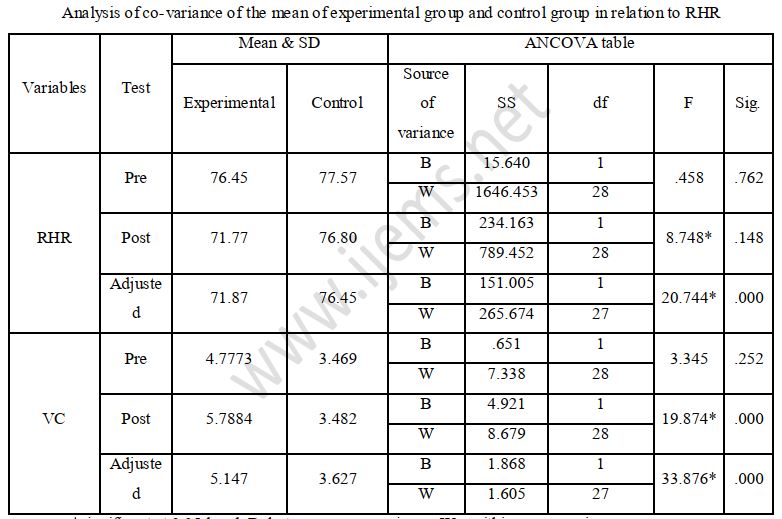PERIODIC EFFECT OF FIVE MINUTE DAILY PLANK TRAINING ON HEART FACTORS
Abstract
The Purpose of the study was to find out the effect of five minute plank training on heart factor that involves resting heart rate. and Vital capacity. 30 male students from K C Public School, Jammu were selected randomly as the subjects for the study. The age of the subjects ranged between 17 – 19 years. For the study pre test – post test randomized group design, which consists of control group (15 students) and experimental group (15 students) was used. The data were collected through the pre test, before training and post test, after six weeks of plank training. For comparing pre and post test means of experimental and control groups of selected physiological variables, descriptive analysis and Analysis of Co-Variance (ANCOVA) were used, the data analyzed with the help of SPSS (21.0 version) software and the level of significance was set at 0.05 level of confidence. It was found that there was significant difference between pre and post test (experimental group) of Resting Heart Rate (RHR) and Vital Capacity (VC). On the basis of the findings it was concluded that the plank training might be responsible for the improvement of Resting Heart Rate and Vital Capacity.
Downloads
References
Ali, A. and Farrally, M. (1991). Recording soccer players’ heart rate during matches. Journal of Sports Sciences, 9, 183-189.
Astrand P-O, Rodahl K, Dahl HA, Stromme SB. (2003) Textbook of work physiology (4th ed.). Windsor: Human Kinetics.
Astrand PO, Rodhal K. (1986) Textbook of work physiology. New York: McGraw-Hill.
Aziz AR, Chia M, Teh KC. (2000) The relationship between maximal oxygen uptake and repeated sprint performance indices in field hockey and soccer players. J Sport Med Phys Fit ; 40(3): 195-200.
Bogdanis GC, Nevill ME, Boobis LH, Lakomy HKA. (1996) Contribution of phosphocreatine and aerobic metabolism to energy supply during repeated sprint exercise. J Appl Physiol; 80: 876-884.
Chanavirut R, Khaidjapho K, Jaree P, and Pongnaratorn P. (2006). Yoga exercise increases chest wall expansion and lung volumes in young healthy Thais. Thai Journal of physiological science,19 (1), 1-7.
Christoper J. Womack et al. (1999). Weight Loss, Aerobic Exercise, Improves Pulmonary Function in Older Obese Men . Baltimore VA Medical Center GRECC, 5(8), 453-457.
Courteix D, Obert P, Lecoq AM, Guenon P, Koch G.( 1997). Effect of intensive swimming training on lung volumes, airway resistance and on the maximal expiratory flowvolume relationship in prepubertal girls. Eur J Appl Physiol Occup Physiol, 76 (3),264- 9.Eleckuvan,
M. R. (2014). Effectiveness of Fartlek Training on Maximum Oxygen Consumption and Resting Pulse Rate. International Journal of Physical Education, Fitness and Sports, 3(1), 85-88.
Kansal, D. K. (2008), Text book of Applied Measurement, Evaluation and Sports Selection. New Delhi, India: Sport and Spiritual Science Publication.
Katona, P.C., McLean, M., Dighton, D.H., Guz, A. (1982). Sympathetic and Parasympathetic Cardiac Control in Athletes and Non-athletes at Rest. Journal of Applied Physiology, 52, 1652-1657.
M. Muralikrishna and P.V. Shelvam. (2014). Effect of different intensities of aerobic training on vital capacity of middle aged obese men. International journal of current research and academic review, 2(8), 85-90.
Mc Ardle WD, Katch FI, Katch VL, (2006) Essentials of Exercise Physiology. 3rd ed. Philadelphia PA: Lippincott Williams and Wilkins.
Paffenbarger, R.S., Lee, I.M.(1996). Physical activity and fitness for health and longevity. Res Q Exerc Sport, 67, 11-28.
Reiman MP, Manske RC. (2009) Functional Testing in Human Performance. Champaign, IL: Human Kinetics.
Sharon A. Plowman, Denise L. Smith (June 2007). Exercise Physiology for Health, Fitness, and Performance. Lippincott Williams & Wilkins. p. 61.
Smith, M.L., Hudson, D.L., Graitzer, H.M., Raven, P.B. (1989). Exercise Training Bradycardia: The Role of Autonomic Balance. Medicine and Science in Sports and Exercise, 21, 40- 44.
Verma, J. P. (2009). A Text Book on Sports Statistics, New Delhi, India: Sports Publication.
Wilmore JH, Costill DL. (2005) Physiology of Sport and Exercise. 3rd ed. Champaign IL: Human Kinetics.















